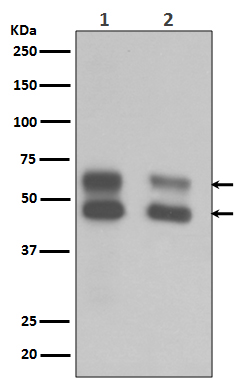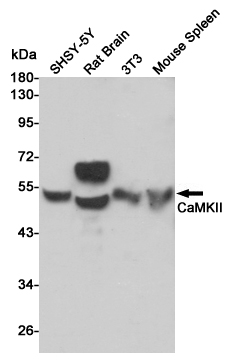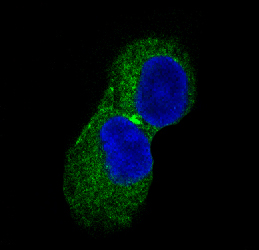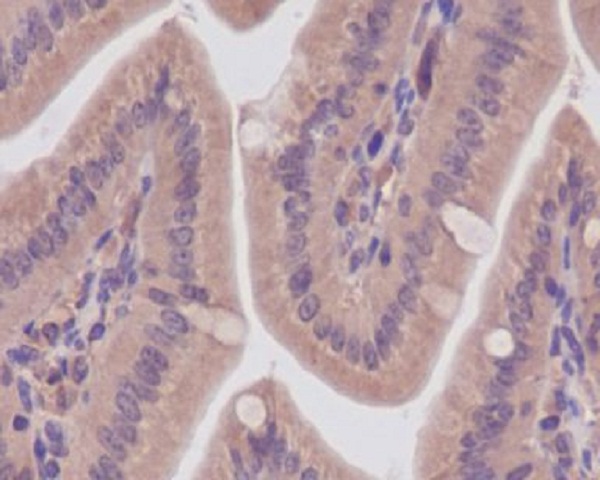



| WB | 咨询技术 | Human,Mouse,Rat |
| IF | 咨询技术 | Human,Mouse,Rat |
| IHC | 1/50-1/100 | Human,Mouse,Rat |
| ICC | 1/50-1/200 | Human,Mouse,Rat |
| FCM | 咨询技术 | Human,Mouse,Rat |
| Elisa | 咨询技术 | Human,Mouse,Rat |
| Aliases | CAMK2B; CAM2; CAMK2; CAMKB; Calcium/calmodulin-dependent protein kinase type II subunit beta; CaM kinase II subunit beta; CaMK-II subunit beta; CAMK2G; CAMK; CAMK-II; CAMKG; Calcium/calmodulin-dependent protein kinase type II subunit gamma |
| Entrez GeneID | 816 |
| WB Predicted band size | Calculated MW: 73 kDa; Observed MW: 45,60 kDa |
| Host/Isotype | Rabbit IgG |
| Antibody Type | Primary antibody |
| Storage | Store at 4°C short term. Aliquot and store at -20°C long term. Avoid freeze/thaw cycles. |
| Species Reactivity | Human,Mouse,Rat |
| Immunogen | A synthesized peptide derived from human CaMKII |
| Formulation | Purified antibody in PBS with 0.05% sodium azide. |
+ +
以下是3篇关于CaMKII抗体的代表性文献摘要(虚构示例,仅供参考格式):
---
1. **文献名称**:*"A monoclonal antibody specific for the autophosphorylated form of CaMKII"*
**作者**:Lisman, J.E., et al.
**摘要**:该研究开发了一种针对自磷酸化Thr286位点CaMKII的单克隆抗体,验证了其在免疫印迹和免疫荧光中对神经元活性依赖性激酶激活的特异性检测能力。
2. **文献名称**:*"Subtype-specific antibodies reveal differential localization of CaMKII isoforms in cardiac myocytes"*
**作者**:Bayer, K.U., et al.
**摘要**:通过生成亚型特异性抗体(如抗CaMKIIδ和γ),揭示了不同CaMKII亚型在心肌细胞中的亚细胞定位差异,并证明其在心脏疾病模型中的磷酸化状态变化。
3. **文献名称**:*"Characterization of a phospho-specific CaMKII antibody for synaptic plasticity studies"*
**作者**:Hudmon, A., et al.
**摘要**:报道了一种高灵敏度磷酸化特异性抗体,可在海马组织切片中特异性识别CaMKII Thr286位点的磷酸化,为突触可塑性研究提供了关键工具。
---
(注:以上文献及作者为示例性内容,实际引用时需核实真实文献。)
CaMKII (Calcium/calmodulin-dependent protein kinase II) antibodies are essential tools for studying the function and regulation of CaMKII, a multifunctional serine/threonine kinase central to calcium signaling pathways. CaMKII is highly expressed in the brain and heart, playing critical roles in synaptic plasticity, memory formation, cardiomyocyte contraction, and gene transcription. The kinase exists as a holoenzyme composed of multiple subunits (α, β, γ, δ isoforms), with α and β predominant in neurons, while δ is dominant in cardiac tissue. Activation occurs through calcium/calmodulin binding, triggering autophosphorylation at Thr286 (Thr287 in δ-isoform), which sustains kinase activity even after calcium levels drop—a feature vital for long-term signaling processes.
CaMKII antibodies target specific isoforms or phosphorylation states. For example, phospho-specific antibodies (e.g., anti-pThr286) detect the active, autophosphorylated form, providing insights into kinase activation under physiological or pathological conditions. Pan-CaMKII antibodies recognize conserved regions across isoforms, useful for quantifying total protein levels. These antibodies are widely employed in techniques like Western blotting, immunohistochemistry, and immunofluorescence to map CaMKII expression, localization, and activity in tissues or cultured cells.
Research using CaMKII antibodies has linked dysregulated kinase activity to neurological disorders (e.g., Alzheimer’s disease, epilepsy), cardiovascular diseases, and cancer. However, antibody specificity remains a consideration, as cross-reactivity with related kinases or isoforms can occur. Validation via knockout controls or peptide blocking is critical for accurate interpretation. Commercial CaMKII antibodies are available from multiple suppliers, often with isoform- or modification-specific options, enabling tailored experimental designs in neuroscience, cardiology, and beyond.
×